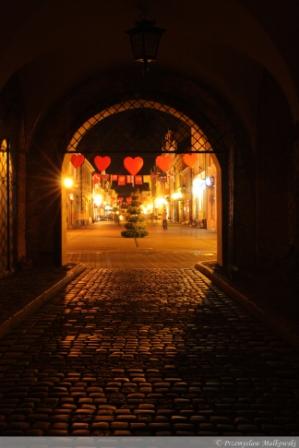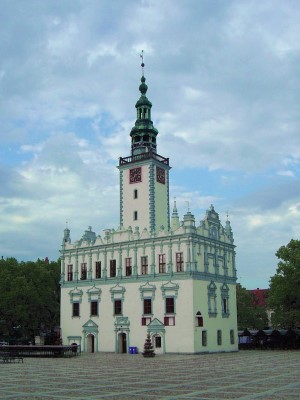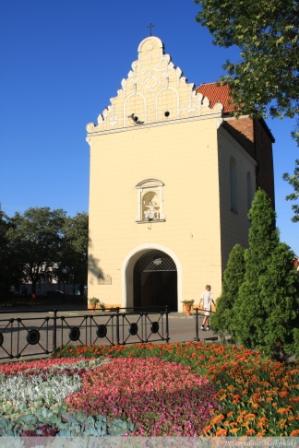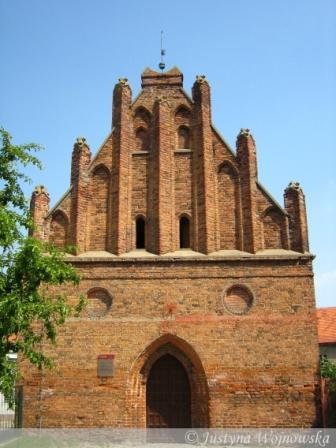Chelmno
Chełmno – town of lovers
History of Chełmno
his 20.5 thousand strong town is situated on the Vistula river bank. In 1233 it was given the municipal rights from the Grand Master of the Teutonic Knights and the local master of the order. In 1244 it was temporarily held by a prince of Pomorze, Swantopolk. In the 1260s the areas of Chełmno were the site of the Old Prussians’ uprisings, and were ravaged by the Yotvingians. The town was initially designed as the capital of the Teutonic Knights’ state, but the fast territorial expansion of the Order altered these plans. In the beginning of the 14th century Chełmno became a Hanseatic town and started to flourish. However, the wars between Poland and Teutonic Knights in the beginning of the 15th century deteriorated the economic situation of the town. Especially after 1457, when the town was captured and governed by Bernard Czimburg, a mercenary commander of the Teutonic Knights’ army during the great war with Poland. After the war, the town was won by Poland. In 1505 king Alexander Jagiellon donated the town to the bishops of Chełmno lands, which lead to a political and economic downfall of the town. After the partitions in 1772, Chełmno became a Prussian domain, and the church property was taken over. In the mid 19th century, Chełmno started to develop industry. The appeared farming machines factory, iron foundry, bell foundry, brickyard, brewery and many smaller companies. In the years of one of the Polish national uprising (1863-1864), a number of the secondary school students from Chełmno took part and fought for their country. Chełmno return to independent Poland in 1920.
City Tour Chełmno
Chełmno can boast of one of the biggest Old Town Squares in Poland and its Town Hall is one of the most interesting renaissance buildings in the country. We will start our walk here. The Town Hall was erected in the years 1567-1572 in the late Gothic style, on the foundations of an earlier town hall building from the end of the 13th century. The eastern elevation of the Town Hall is known for its portal from 1572, and the western is famous for its standard of measurement, the so called “Chełmno Bar” (143 cm). The bar was divided into smaller units of measurement, such as ells, feet and steps.
Our next step will be the South-West corner of the Square, where we will see the Gothic Parish Church of Assumption of Our Lady, a brick hall church, erected in the years 1280-1320. The church tower is on its northern side. The church is a treasure of Gothic art and architecture, both as regards its interior and exterior. In the church, it’s worth paying attention to the 17th century stalls, placed on both sides of the chancel, the pictures of Polish saints and the beatified, and the main altar from 1710 with the patron saint of the church. The church is also furnished with numerous sculptures, epitaph plaques and headstones, polychrome, a Gothic stone stoup from the end of the 13th century, and a baptismal font from the 14th century, with a brass lid from the 17th century. Another item of interest is the so called melusine – a candlestick shaped like a deer’s head that is sensitive to the changes in the air humidity, a kind of a 17th century barometer. For centuries, the church has held the holy reliquia of St. Valentine, patron saint of love. The reliquia are placed in a silver reliquary from the 18th century.
Heading down Franciszkańska Street, we cross 22 Stycznia Street and find the girdle of the town’s Gothic defensive walls that date back to the turn of the 13th and 14th centuries. The walls are 2800 metres long and nearly completely preserved.
On the right we can see the Powder Donjon, believed to be haunted by the damned spirit of Bernard Czimburg. We continue our walk along the walls and reach St. Martin’s Chapel from the 15th century (on the left, near a school’s playground). We cross the Toruńska Street and continue to another Gothic church, the Holy Spirit Church, built in the years 1280-1290. Adjacent to the southern wall of the church, there used to be a hospital for the poor, lead by the monks of the Holy Spirit Order. Getting inside the church, we will see that the nave is visibly taller than the aisles. This means that the church is a basilica. The interior is modest, with 16th century paintings. We then go down the Ducha Świętego Street, turn left into the Gen. Hallera Street and right into 22 Stycznia Street. The long grey building on the right is the former barracks from the 18th century, belonging to the Corps of Cadets. We continue down the 22 Stycznia Street, reach the defensive walls and turn left into Podmurna Street. Ahead of the junction with the Grudziądzka Street, on the right, there is one of the two town gates, preserved to our times: Grudziądzka Gate. It dates back to the 14th century. In the beginning of the 17th century the gate was rebuilt and a renaissance chapel was added. It used to store the icon of Chełmian Virgin Mary of Sorrows.
We go back to the Square down the Grudziądzka Street, passing the Poprzeczna Street. At the next junction we turn right into the Wodna Street that leads to another gothic church of St. St. Peter and Paul. This post-Dominican church was erected at the turn of the 13th and 14th centuries and rebuilt in the 17th century. The main altar from the 18th century, placed in the chancel and the headstone of the first bishop of Chełmno, Heidenryk, from 1360, are really impressive.
Leaving the church, we enter the Dominikańska Street, which leads us the former Cistercian monastery complex from the 14th century. The Cistercian nuns united with the Benedictine nuns in the 15th century. The complex includes the church of St. John the Baptist and St. John the Evangelist, built in mid 14th century in the Gothic style. We enter the church through the main portal, carved in sandstone around 1619. What captures attention is the main, baroque altar from the turn of the 17th and 18th centuries, with a picture showing the patron saints of the church. I
In the Mary Magdalene chapel we can see the oldest headstone in the region of Chełmno, Arnold Lischoren’s headstone from 1275. There is also a Gothic sculpture from 1380, depicting the Mysterious Christ. The richly furnished interior includes the exquisite 16th century stalls and organ front from the beginning of the 17th century. The monastery presently belongs to the Sisters of Our Lady of Mercy. The complex includes the former convent – a brick building from the first half of the 14th century, adjacent to the western wall of the church, the Gothic Merseburska Gate from the beginning of the 14th century and the chapel of the Tomb of Christ, as well as a donjon, presently called the Mestwin’s Tower. The tower is probably a part of the former seat of the Teutonic Knights.
Leaving the monastery complex, we enter the Klasztorna Street. On the left, in the Biskupia Street, we can see the last Gothic church of Chełmno. It is St. Jacob the Older and St. Nicolas church, a post-Franciscan hall church built in the 14th century. Regrettably, the original furnishing is not preserved. Still, the church constitutes an interesting example of Franciscan architecture. We continue down the Klasztorna Street, reach the Szkolna Street and turn left into the Town Square. Before we get there, pay attention to the house of the famous Chełm Academy that was active in the 17th and 18th centuries, situated at the corner of the Szkolna and Franciszkańska Streets.
On the Old Town Square our walk comes to an end.
| History of | City Tour | Photo Gallery |
History of Chełmno
his 20.5 thousand strong town is situated on the Vistula river bank. In 1233 it was given the municipal rights from the Grand Master of the Teutonic Knights and the local master of the order. In 1244 it was temporarily held by a prince of Pomorze, Swantopolk. In the 1260s the areas of Chełmno were the site of the Old Prussians’ uprisings, and were ravaged by the Yotvingians. The town was initially designed as the capital of the Teutonic Knights’ state, but the fast territorial expansion of the Order altered these plans. In the beginning of the 14th century Chełmno became a Hanseatic town and started to flourish. However, the wars between Poland and Teutonic Knights in the beginning of the 15th century deteriorated the economic situation of the town. Especially after 1457, when the town was captured and governed by Bernard Czimburg, a mercenary commander of the Teutonic Knights’ army during the great war with Poland. After the war, the town was won by Poland. In 1505 king Alexander Jagiellon donated the town to the bishops of Chełmno lands, which lead to a political and economic downfall of the town. After the partitions in 1772, Chełmno became a Prussian domain, and the church property was taken over. In the mid 19th century, Chełmno started to develop industry. The appeared farming machines factory, iron foundry, bell foundry, brickyard, brewery and many smaller companies. In the years of one of the Polish national uprising (1863-1864), a number of the secondary school students from Chełmno took part and fought for their country. Chełmno return to independent Poland in 1920. |  |  |
City Tour Chełmno
Chełmno can boast of one of the biggest Old Town Squares in Poland and its Town Hall is one of the most interesting renaissance buildings in the country. We will start our walk here. The Town Hall was erected in the years 1567-1572 in the late Gothic style, on the foundations of an earlier town hall building from the end of the 13th century. The eastern elevation of the Town Hall is known for its portal from 1572, and the western is famous for its standard of measurement, the so called “Chełmno Bar” (143 cm). The bar was divided into smaller units of measurement, such as ells, feet and steps. Our next step will be the South-West corner of the Square, where we will see the Gothic Parish Church of Assumption of Our Lady, a brick hall church, erected in the years 1280-1320. The church tower is on its northern side. The church is a treasure of Gothic art and architecture, both as regards its interior and exterior. In the church, it’s worth paying attention to the 17th century stalls, placed on both sides of the chancel, the pictures of Polish saints and the beatified, and the main altar from 1710 with the patron saint of the church. The church is also furnished with numerous sculptures, epitaph plaques and headstones, polychrome, a Gothic stone stoup from the end of the 13th century, and a baptismal font from the 14th century, with a brass lid from the 17th century. Another item of interest is the so called melusine – a candlestick shaped like a deer’s head that is sensitive to the changes in the air humidity, a kind of a 17th century barometer. For centuries, the church has held the holy reliquia of St. Valentine, patron saint of love. The reliquia are placed in a silver reliquary from the 18th century.
Heading down Franciszkańska Street, we cross 22 Stycznia Street and find the girdle of the town’s Gothic defensive walls that date back to the turn of the 13th and 14th centuries. The walls are 2800 metres long and nearly completely preserved.
On the right we can see the Powder Donjon, believed to be haunted by the damned spirit of Bernard Czimburg. We continue our walk along the walls and reach St. Martin’s Chapel from the 15th century (on the left, near a school’s playground). We cross the Toruńska Street and continue to another Gothic church, the Holy Spirit Church, built in the years 1280-1290. Adjacent to the southern wall of the church, there used to be a hospital for the poor, lead by the monks of the Holy Spirit Order. Getting inside the church, we will see that the nave is visibly taller than the aisles. This means that the church is a basilica. The interior is modest, with 16th century paintings. We then go down the Ducha Świętego Street, turn left into the Gen. Hallera Street and right into 22 Stycznia Street. The long grey building on the right is the former barracks from the 18th century, belonging to the Corps of Cadets. We continue down the 22 Stycznia Street, reach the defensive walls and turn left into Podmurna Street. Ahead of the junction with the Grudziądzka Street, on the right, there is one of the two town gates, preserved to our times: Grudziądzka Gate. It dates back to the 14th century. In the beginning of the 17th century the gate was rebuilt and a renaissance chapel was added. It used to store the icon of Chełmian Virgin Mary of Sorrows.
 |  |  |
We go back to the Square down the Grudziądzka Street, passing the Poprzeczna Street. At the next junction we turn right into the Wodna Street that leads to another gothic church of St. St. Peter and Paul. This post-Dominican church was erected at the turn of the 13th and 14th centuries and rebuilt in the 17th century. The main altar from the 18th century, placed in the chancel and the headstone of the first bishop of Chełmno, Heidenryk, from 1360, are really impressive.
Leaving the church, we enter the Dominikańska Street, which leads us the former Cistercian monastery complex from the 14th century. The Cistercian nuns united with the Benedictine nuns in the 15th century. The complex includes the church of St. John the Baptist and St. John the Evangelist, built in mid 14th century in the Gothic style. We enter the church through the main portal, carved in sandstone around 1619. What captures attention is the main, baroque altar from the turn of the 17th and 18th centuries, with a picture showing the patron saints of the church. I
In the Mary Magdalene chapel we can see the oldest headstone in the region of Chełmno, Arnold Lischoren’s headstone from 1275. There is also a Gothic sculpture from 1380, depicting the Mysterious Christ. The richly furnished interior includes the exquisite 16th century stalls and organ front from the beginning of the 17th century. The monastery presently belongs to the Sisters of Our Lady of Mercy. The complex includes the former convent – a brick building from the first half of the 14th century, adjacent to the western wall of the church, the Gothic Merseburska Gate from the beginning of the 14th century and the chapel of the Tomb of Christ, as well as a donjon, presently called the Mestwin’s Tower. The tower is probably a part of the former seat of the Teutonic Knights.
Leaving the monastery complex, we enter the Klasztorna Street. On the left, in the Biskupia Street, we can see the last Gothic church of Chełmno. It is St. Jacob the Older and St. Nicolas church, a post-Franciscan hall church built in the 14th century. Regrettably, the original furnishing is not preserved. Still, the church constitutes an interesting example of Franciscan architecture. We continue down the Klasztorna Street, reach the Szkolna Street and turn left into the Town Square. Before we get there, pay attention to the house of the famous Chełm Academy that was active in the 17th and 18th centuries, situated at the corner of the Szkolna and Franciszkańska Streets.
On the Old Town Square our walk comes to an end.
Kategoria:
English
Tytuł:
Chelmno


